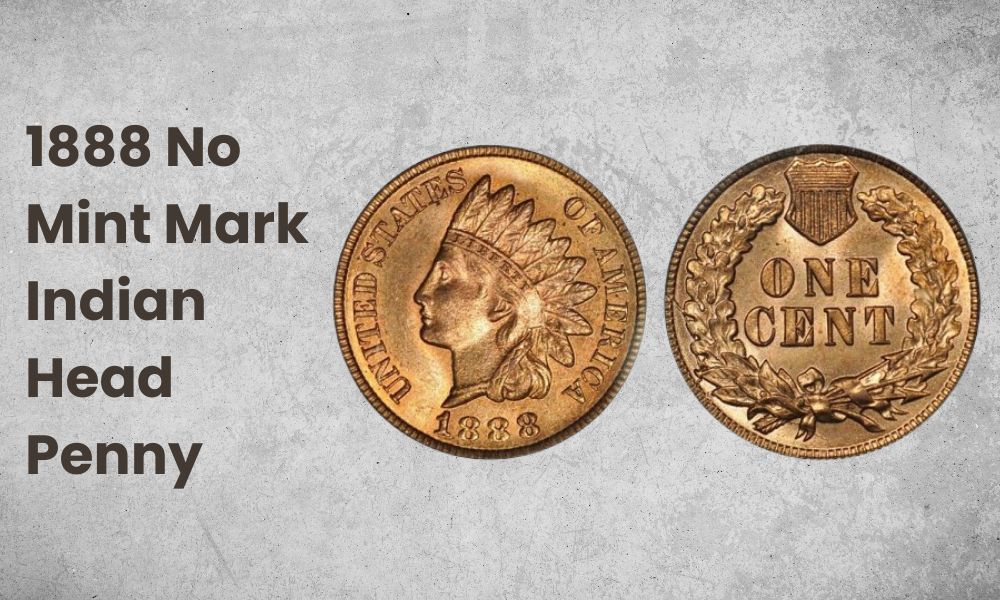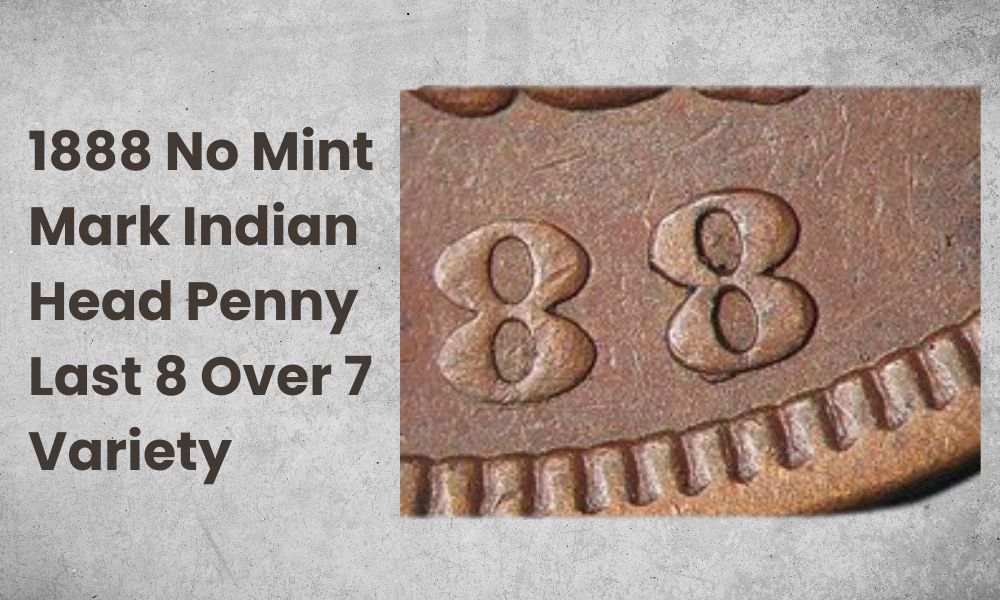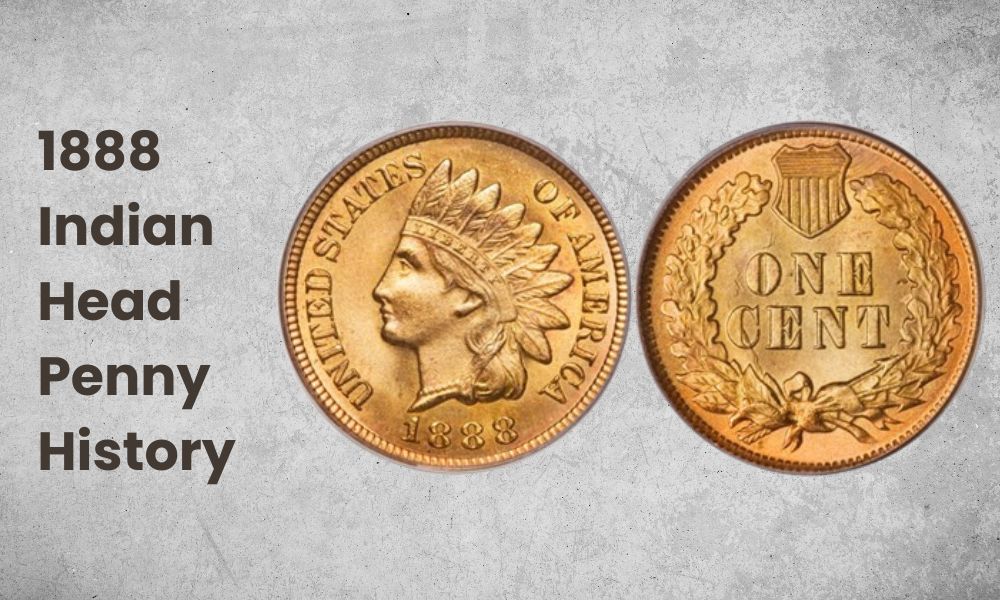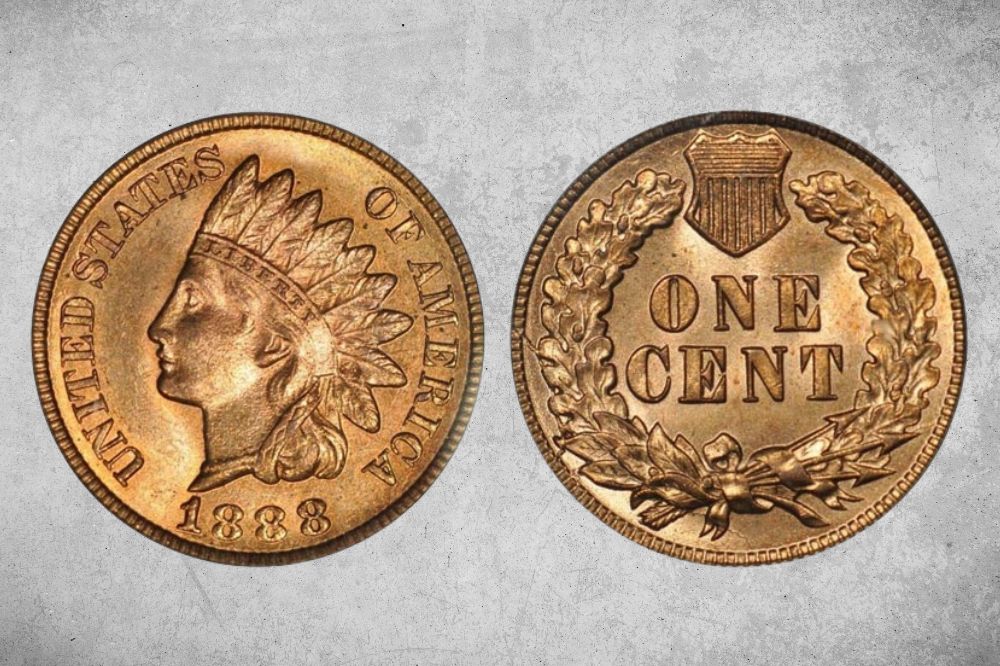The 1888 Indian head Penny is a fairly popular coin that has been prized by collectors for many years. This penny is a valuable coin in the United States, and it has an interesting history and a couple of features that make it unique.
In this blog post, we will explore the 1888 Indian head penny’s value, its obverse and reverse designs, errors to look out for, how to grade your 1888 Indian head penny, and more. Whether you are looking to add this rare penny to your collection or just want to learn more about it, this guide has all the information you need!
Ready to begin? Let’s go!
1888 Indian Head Penny Details
- Category: Indian head pennies
- Mints: Philadelphia
- Total mintage: 37,489,832+
- Obverse designer: James B. Longacre
- Reverse designer: James B. Longacre
- Edge: Plain
- Diameter: 19.05 millimeters (0.75 inches)
- Thickness: 1 millimeter (0.039 inches)
- Composition: 95% copper, 5% tin and zinc
- Weight: 3.1 grams
The 1888 Indian head penny is a pretty interesting coin. It has a copper composition, weighing 3.11 grams, having a diameter of 19 millimeters, which is .75 inches and about the same size as the modern penny. The 1888 Indian head penny also features a plain edge and has two sides: the obverse and reverse designs.
The 1888 Indian Head Penny was minted by the United States Mint at only one location. It was produced in Philadelphia, Pennsylvania. While most US Mint locations have a letter that is stamped on the coin in order to identify where they came from (such as an “S” standing for the US Mint in San Francisco), there is no mint mark for the US Mint in Philadelphia.
On the obverse side of the 1888 Indian head penny is a profile of Lady Liberty wearing a Native American-style feathered headdress. Around her is the phrase “UNITED STATES OF AMERICA” and the date “1888”.
On the reverse, there is an oak wreath featured, leading up to a mighty shield at the top of the coin – in fact, the shield looks very similar to the shield on the modern penny’s reverse, too. The oak wreath is tied at the base with a ribbon, and within the ribbon are a grouping of arrows, symbolizing strength. It also bears the inscription “ONE CENT” at the center.
Also Read: Top 20 Most Valuable Old Pennies Worth Money (Penny Collection)
Value Chart
1888 Indian Head Penny Value Chart |
|||||
| Mint Mark | Good | Fine | Extremely Fine | Uncirculated | Proof |
| 1888 No Mint Mark Indian Head Penny | $4.63 | $6.80 | $28 | $85-$173 | $292 |
| 1888 No Mint Mark Indian Head Penny (8 Over 7) | $1,898 | $5,251 | $8,716 | $40,009-$74,201 | / |
1888 Indian Head Penny Values and Varieties Guide
Now that you know a bit more about the 1888 Indian head penny, let’s talk about its value. The 1888 Indian head penny is a rare and valuable coin and can bring in much more than its face value (one cent) in all conditions, but its value does vary to some degree depending on the grade of the coin. Not to mention, there is an interesting variety coin from this date, which we will look at below in greater detail.
Here is more information about the 1888 Indian head penny’s value based on its condition:
1888 No Mint Mark Indian Head Penny Value

- Type: Indian head penny
- Edge: Plain
- Mint mark: None
- Place of minting: Philadelphia
- Year of minting: 1888
- Face value: $0.01
- $ price: $4.63 to $292
- Quantity produced: 37,489,832
- Designer: James B. Longacre
The 1888 no mint mark Indian head penny was minted in Philadelphia, Pennsylvania. As we mentioned before, Philadelphia was the only US Mint location for the 1888 Indian head penny, and it had a mintage of over 37 million coins.
In “Good” condition, this fine coin is worth about $4.63. At “Fine” condition, 1888 no mint mark Indian head pennies are worth around $6.80 each.
At the “Extremely Fine” condition grade, the value jumps significantly. At this level, a single Indian head cent is worth $28! For a coin with a $0.01 face value, that’s quite an increase in valuation.
Also, at “Uncirculated” condition, which ranges from near mint to mint condition, the 1888 no mint mark Indian head penny can be between $85 and $173 each.
Of course, if you’re lucky enough to sell a mint state Indian head penny at auction, you may just sell it for a whopping $15,000 or $63,000 like two certain coins did recently! This is rare, however, and would have to be met with the right buyer and an insanely perfect coin grade.
And last but certainly not least, there was a Proof coin for this date in history. A Proof coin is a specially created coin with polished dies and planchets, resulting in a beautiful mirror-like finish that is usually worth much more than regular circulation coins. 1888 Proof Indian head pennies are worth about $292!
1888 “No Mint Mark” Indian Head Penny Value – Last 8 Over 7 Variety

- Type: Indian head penny
- Edge: Plain
- Mint mark: None
- Place of minting: Philadelphia
- Year of minting: 1888
- Face value: $0.01
- $ price: $1,898 to $74,201
- Quantity produced: n/a
- Designer: James B. Longacre
The 1888 Indian head penny has a rare and valuable variety coin. It is called the 1888 no mint mark Indian head penny, the “Last 8 Over 7” variety.
What this means, essentially, is that the year 1888 was stamped overtop of the previous year’s date: 1887. So, all the digits are the same, of course, except the last one. The last digit of the date (an “8”) was stamped overtop of the “7” from the previous year.
You can tell if you have one of these coins by using a coin microscope to inspect the last “8” on the date. If there is a little nodule coming off the bottom left of the “8” then you have a piece of a “7” showing itself. Or, the top of the “7” may show at the top of the “8” instead.
This 1888 Indian head penny variety is very rare and desirable, and no one knows exactly how many of these were made. The values begin at $1,898 for a “Good” grade, which is already significantly higher than any of the standard no mint mark pennies from 1888!
At the grade of “Fine,” these Indian head pennies are worth about $5,251, and they steadily climb from there. An “Extremely Fine” example is worth about $8,716, and Uncirculated examples can be worth even more – anywhere from a whopping $40,009 to $74,201 or higher!
Not too shabby for a penny!
Also Read: Top 15 Most Valuable Indian Head Penny Worth Money
1888 Indian Head Penny History

The 1888 Indian head penny is part of a series of Indian head pennies created by the United States Mint. These coins were designed to replace the earlier “Flying Eagle” cent coins (which was an extremely short lived design, minted only from 1856 to 1858). The Indian head penny began business circulation in 1859 and would last until the year 1909.
The design of the obverse and reverse of the 1888 Indian head penny was the product of U.S. Mint engraver James Barton Longacre. When he was tasked with creating a design that would outlast the Flying Eagle cents, he certainly delivered. His 1888 Indian head penny design is one of the most recognizable and widely collected coins in US history.
The 1888 Indian head penny is an iconic coin that has been beloved by collectors for generations. Its attractive design, rarity, and historical significance make it a highly interesting collectible – especially the rare variety coin!
1888 Indian Head Penny Grading
Collectors will often look for 1888 Indian head pennies that are in “Extremely Fine” or “Uncirculated” condition as these tend to command the highest prices. Additionally, 1888 Indian head pennies can be valuable to avid collectors for their variety or error coins, as we have discussed.
When assessing the value of an 1888 Indian head penny, it’s important to consider the condition (or grade) of your coin. Grading is done on a scale ranging from “Good” to “Uncirculated”, with each grade representing different levels of wear or preservation. Coins graded “Good” or “Fine” may show some signs of wear but still retain most of the details of their design, while coins graded “Extremely Fine” or “Uncirculated” are in near perfect condition.
Grading is a fairly subjective process, although there are certain standards to be upheld during inspection, and it’s recommended that you consult a professional grading company in order to determine an accurate grade for your 1888 Indian head penny.
In addition to its grade, as with any coin, 1888 Indian head pennies should always be stored carefully to preserve their condition – and never ever clean them! Cleaning any coin can damage its surface and significantly reduce its value.
1888 Indian Head Penny Errors
Truth be told, the 1888 Indian head penny error coins are hard to come by. Really, just about the only known errors found on the pennies from this year are the variety pennies with the date “1888” re-punched overtop the “1887” date.
As we have mentioned earlier in this blog post, coins with this variety can sell for multiple five figures if their grade is high enough, and if their grade is low, it’s still reasonable to expect to receive four figures for them from a buyer.
However, it’s important to keep in mind that just because there aren’t any other error coins currently known, that doesn’t mean that they do not exist! Any single coin may have an error, so if you find yourself with an 1888 Indian head penny, you will definitely want to pull out that coin microscope and start thoroughly inspecting it for anything that seems amiss. You just never know what you might find!
1888 Indian Head Penny Frequently Asked Questions
Now that we’ve gone over 1888 Indian head penny information from history to grading, it’s time to answer some of the most frequently asked questions about this iconic coin that numismatists love and collect:
What is the 1888 Indian Head Penny Made Of?
The 1888 Indian head penny was struck mainly in copper. However, it isn’t entirely constructed of copper – it also contains some tin and zinc. This is a 95% and 5% split between the three metals, and the composition is known as bronze.
Some other dates of the Indian head penny were constructed of cupronickel, which is a mixture of copper and nickel, as the name would suggest.
How Much is a 1888 Indian Head Penny Worth?
The value of a 1888 Indian head penny can vary greatly, depending on its condition and variety. On the low end, 1888 Indian head pennies in Good or Fine condition can be worth anywhere around a few dollars. However, 1888 Indian head penny error coins with the re-punched date can fetch thousands of dollars, such as $74,000, if they are in high grade!
How do I Determine the Value of my 1888 Indian Head Penny?
The value of 1888 Indian head pennies depends on their condition, grade, variety, and errors. It’s recommended that you consult a professional grading company to determine an accurate grade, since it’s easy to misgrade your 1888 Indian head penny on your own. Additionally, a rare variety in a high grade can be much more valuable than a regular 1888 Indian head penny.
Where Can I Find 1888 Indian Head Pennies for Sale?
1888 Indian Head pennies can be found from a variety of sources, including coin dealers, auction houses, and online coin marketplaces. It’s important to research the seller carefully before making any purchase to ensure that they are a trustworthy source.
Additionally, 1888 Indian head penny values vary greatly depending on their condition, grade, variety and errors, so it’s always recommended that you consult a professional or read up on grading standards to ensure you’re getting the best value for your money.
Conclusion
In conclusion, the 1888 Indian head penny is one of the most desirable coins in United States history. Its value, depending on its condition and variety, can range from a few dollars to several thousand of dollars.
It’s important to understand the 1888 Indian head penny’s history, obverse and reverse designs, errors to look out for, how to grade your 1888 Indian head penny, and more so that you can have a better understanding of its value when assessing it. You want to make sure you get the best bang for your buck.
We hope this guide has provided you with the information that you need in order to understand and appreciate your 1888 Indian head penny! Still have questions? Let us know in the comments below!
